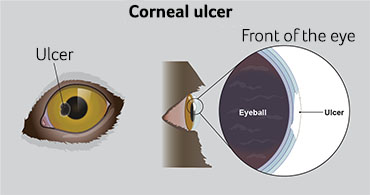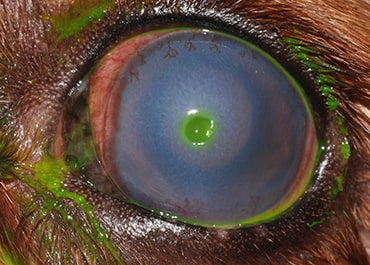Eye ulcers (corneal ulcers) in dogs
Overview
An eye ulcer is a wound on the front of the eye; they are very painful and can develop for many different reasons.
Ulcers often appear suddenly and get rapidly worse. However, eyes heal quickly so with vet treatment an ulcer is likely to heal within a few days (unless complications develop).
Leaving an ulcer without veterinary treatment can result in loss of an eye.
Contact your vet ASAP if you notice anything wrong with your dog’s eyes – they are too important to leave to chance.
Corneal ulcers explained
Eye ulcers (also called ‘corneal ulcers’) are damage to the surface of the eye. Ulcers vary from being very shallow (a minor graze or scratch) to much deeper and more serious.
The front of the eye is very thin, deep ulcers can cause the eye to burst. A burst eye may need removal or referral to a specialist eye clinic. If caught early enough, surgery to repair a burst eye is occasionally possible.
Common causes include injuries, dry eye, infections and entropian (in-turning eyelids).
Indolent ulcers and melting ulcers are two, very serious types of eye ulcer that need special, intensive treatment. Read articles on these particular types of ulcer for more information.
Eye ulcers can be very painful and can quickly get worse if left untreated.

Eye ulcers (also called ‘corneal ulcers’) are damage to the surface of the eye. Click image to enlarge.
Symptoms
Symptoms of an eye ulcer include:
- Red, inflamed, blood shot eye
- An obvious hole or crater on the surface of their eye
- Closed eye or squinting
- Blinking more than usual
- Weepy eye
- Cloudy eye
- Scratching and rubbing at the face and eye
- Avoiding bright lights.

A deep ulcer in a dog’s eye, highlighted by a green dye. Image courtesy of Eye Veterinary Clinic.
Causes
So how did your dog get a corneal ulcer? Possible causes include:
Dry eye
- Dry eye (lack of tears) causes eyes to become irritated and painful, and is a common cause of ulcers in dogs. Your vet may test for dry eye if your dog regularly suffers from ulcers.
Injury
- Injuries such as stick injuries and cat scratches are a common cause of eye ulcers.
Something in the eye
- Something stuck in the eye such as a grass seed or grit (usually behind the third eyelid) can cause an ulcer.
Eyelid problems
- Eyelid problems such as entropian (turning in of the eyelids) causes rubbing, pain and often ulcers.
Eyelash problems
- Eyelashes growing in the wrong place or at a strange angle can cause irritation and eye ulcers.
Eye infections
- Both bacterial (bacterial conjunctivitis) and viral eye infections can cause eye ulcers.
Breeds at high risk
Short nosed dogs are at a much higher risk of eye ulcers because their eyes bulge forward and are very exposed. Dogs that suffer from eye conditions such as dry eye are also at a higher risk of an ulcer. Breeds at risk include:
- Pug
- Shih Tzu
- Bulldog
- Boxer
- West Highland Terrier
- Cavalier Kind Charles Spaniel.
Treatment
Treatment depends upon how severe your dog’s ulcer is and may include:
A buster collar
- A buster collar will prevent your dog from rubbing or scratching at their eye whilst it heals. This is vitally important for the treatment of an ulcer.
Eye drops
- Antibiotic eye drops or ointments may be given to prevent infections developing while the ulcer heals. Antibiotic drops usually need to be given 2 – 4 times a day.
- Lubricating drops (similar to false tears) may be used to sooth the front of the eye and keep it moist while it heals.
- Atropine eye drops may be given if your dog has developed a tiny pupil (a common problem in painful eyes).
- If you have more than one drop to apply our medication planner may come in helpful.
Anti-inflammatory pain relief
- Non-steroidal anti-inflammatory drugs are excellent at reducing pain and swelling.
Antibiotic tablets
- Antibiotics tablets aren’t always necessary but may be prescribed if your vet is particularly worried about your dog’s eye developing an infection.
Surgery
 Video found at youtu.be/VZHtrertQNY
Video found at youtu.be/VZHtrertQNY
Non-healing ulcers
If your dog has an ulcer that isn’t healing as quickly as expected, your vet may decide to take further action. This may include:
- Swabbing the front of the eye to check for infection.
- Changing your dog’s eye drops.
- Performing a minor procedure called ‘debridement’ or a grid keratotomy. Both are simple procedures that help heal the ulcer.
Prevention
There isn’t much you can do to prevent eye ulcers but some sensible precautions include:
- Protecting short nosed dogs from running into hedges, sharp table corners etc.
- Cat scratches are a common cause of eye ulcers in dogs – if your two furry friends don’t see ‘eye-to-eye’, keep them separate!
- Visit the vet ASAP if you notice any problems with your dog’s eye.
Cost
Treatment for eye problems such as ulcers can become very expensive. Consider insuring your dog as soon as you get them, before any signs of illness start. Then you have all the support you need to care for them.
It’s also very important to speak openly to your vet about your finances, the cost of treatment, as well as what you think is right for your dog. There is often several treatment options so if one doesn’t work for you and your pet then the vet may be able to offer another.
Published: December 2018
Did you find this page useful?
Tell us more
Please note, our vets and nurses are unable to respond to questions via this form. If you are concerned about your pet’s health, please contact your vet directly.
Thank you for your feedback
Want to hear more about PDSA and get pet care tips from our vet experts?
Sign up to our e-newsletter
Written by vets and vet nurses. This advice is for UK pets only. Illustrations by Samantha Elmhurst.

